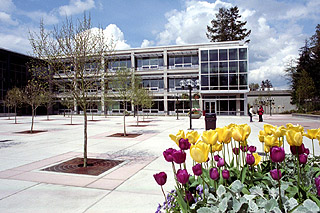
DJC.COM
March 30, 2006
Tips for designing an energy-efficient building
CDi Engineers

|
That was the admirable (if very ambitious) goal the AIA national board of directors set forth in December. The issue is important because buildings consume about 40 percent of our nation's energy — a larger chunk than even automobiles.
Designers, however, have been left scratching their heads. How exactly does a well-meaning design team go about putting the group's policy into practice? Clearly, traditional approaches such as high-performance glazing and more-efficient motors for HVAC systems won't be enough to achieve AIA's goals.
Smart siting

Photo courtesy of CDi Engineers
Bellevue Community College used ground-coupled heat pumps in Building R, cutting the building’s energy costs by 30 percent.
|
Just selecting the right location and position for your building on the site can do wonders for energy efficiency. Orienting a building along a north-south axis creates maximum solar heat gains on the east and west faces, and causes almost constant glare for people on either exposure for half of every day.
Using an east-west axis, on the other hand, provides solar gain on the south face in winter, when the sun's rays are closer to the horizon, helping to warm the building and offer natural lighting. It's also easy to shade the southern exposure with overhangs for protection in the summer, when harsh rays cause glare. The best exposure from a lighting standpoint is north, where glare is never a problem.
Another benefit of an east-west orientation comes from natural ventilation. Winds in our region tend to blow from the southwest in winter and northwest in summer. A long, narrow building facing the optimum direction can be cooled by fresh breezes, reducing air conditioning costs.
Heating, cooling technologies
Today, most buildings are cooled by blasting large quantities of air from the ceiling, which uses a lot of energy.
Instead, new chilled-beams technology uses convective cooling elements in the ceiling, moving a small amount of water instead of a large amount of air. Powerful fans are not needed. When coupled with a natural ventilation system, this chilled-beam hybrid system is a simple way to potentially save up to 30 percent of traditional energy costs.
Another smart idea is to heat or cool the air near a specific person, rather than an entire room, with under-floor air distribution. Office occupants, with vents under their desks, can control the temperature of their space by adjusting the volume of air they receive.
Marion Oliver McCaw Hall at Seattle Center uses this concept on a large scale to condition only the audience environment instead of the entire opera hall.
Ground-coupled heat pumps can diminish energy requirements by 30 percent when integrated with a good building envelope design. Since the ground temperature is relatively constant throughout the year, it can be used to heat or cool a building. Bellevue Community College's Building R is a great local example of a building that uses this type of system.
Although the technologies mentioned above are not common in the United States, designers in Europe frequently use one or more to great advantage. A bank built recently in England incorporates all three — chilled beams, under-floor air and a heat pump loop to reduce energy costs for the building.
Daylighting
Proven strategies should be implemented whenever possible, especially daylighting — using natural light from windows or skylights to complement artificial sources. Since artificial lighting is typically the largest energy consumer in any building, good daylighting can cut total energy consumption by 10 percent.
Yet the majority of buildings being designed today are not daylighted to maximum capability. Proper daylighting also cuts down on air conditioning costs since electric lights generate heat.
The right color of paint on interior walls can also cut lighting costs, even at night. So can proper controls, which use a sensor to regulate how many lights are turned on, or make sure that lights are turned off when a building is empty.
Collaborate early
Most energy technologies are either made possible or prohibited by the building's architecture.
For example, not just any window provides good daylighting. Glazing, sizing, positioning and add-ons such as overhangs all affect the amount of natural light coming into the building. These are often established before engineers can bring energy-efficiency ideas to the table.
The best solution is to bring together different disciplines as early as possible in the design process.
Architects often want to make a building aesthetically pleasing with lots of glass. Electrical engineers want to throw in as many watts as possible to meet foot-candle requirements. Mechanical engineers may want small, dark windows for greater mechanical efficiencies. Cooperation between disciplines at the outset of the project helps to balance tradeoffs.
Early cooperation can also result in other benefits. Chilled beams eliminate the need for big ceiling ducts, so floor-to-floor heights can be reduced. This can potentially allow an extra floor or two in a large building, increasing revenues for the owner.
Joe Llona is director of sustainable design at CDi Engineers, a mechanical engineering firm with headquarters in Lynnwood.
Other Stories:
- Toward a sustainable future in South Lake Union
- Historic preservation projects can be green
- Low-impact development gets a test in Renton
- Smart lighting design: go for timeless, not trendy
- Brownfield project demonstrates Seattle's creative know-how
- 3 advances show the future of site development
- What does a sustainable school cost?
Copyright ©2009 Seattle Daily Journal and DJC.COM.
Comments? Questions? Contact us.